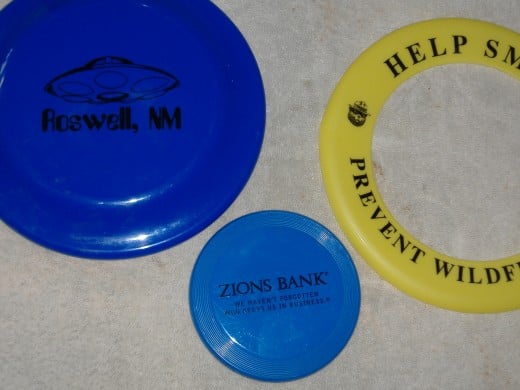Frisbees: The Toy That Defies The Rules



The Sports side of the Frisbee
There are several sports that evolved from the introduction of the frisbee that have their own professional organizations (as well as hubs about each sport), and probably many others (official and UN-official) that aren’t mentioned here.
Ultimate Frisbee (think a combination of football and soccer) UPA
Disc golf (or Frisbee golf using baskets instead of holes) PDGA
Frisbee Freestyle (performing acrobatic stunts with a Frisbee) Freestyle Players Association
Want a collectable that defies the rules? Try the Frisbee. It's over 50 years old and is still a popular toy for all ages. It has spawned a variety of games; Ultimate Frisbee, and Disc Golf being two of the more popular. Many advertisers, organizations, and tourist shops have at various times put their logos on the flying saucers and hawked them to the masses. It is rare to go to a special event and not find some incarnation of the Frisbee available, and even dogs have got into the act with their owners in catching the Frisbee thrown by their owner.
Various toy companies have put out their own versions of the Frisbee (which is actually the trade name given to the toy by Whammo back in January 1957 when the Frisbee was first launched,) but this toy's history goes back much further than that. The year was 1871 and a man named William Russell Frisbie opened a pie store near what would eventually become Yale University. Many college students frequented the pie store, and after devouring the pies found that the pie pans when turned upside down and thrown properly flew quite well (and that of course was a lot of fun). The idea spread from college to college to college, but no one thought to market the idea until after World War II. (It is interesting to note that pie companies still put their name on their pans today, if you're interested in another collectable.) Unfortunately, the Frisbie pie company went out of business in 1958, a year after the Frisbee was launched.
Finally, after World War II, two men on different coasts decided to try to market the flying pie pans. Ernest C. (Bill) Robes began peddling his Space Saucer on the east coast. He also got a patent on his disc, but the patent claims were so narrow that the flying disc eventually marketed by Whammo as the Frisbee was not covered under that patent.
Meanwhile, on the west coast Walter Fredrick Morrison was building his own version of the inverted pie pan, and hawking it as the Pluto Platter. After a couple years he met up with Rich Knerr and A.K. (Spud) Melin (the founders of Whammo) and discussed his idea with them. In January of 1957 they launched the Frisbee, and the rest is history.
Now there are contests and dozens of games that are played with the Frisbee, but how it flies is still a complex set of contradictions that kept the physicists hopping for quite a while. We now know that it is a combination of aerodynamics (the profile is shaped like an airplane wing) and rotational dynamics (gyroscopic motion keeps it stable as it moves through the air). The intrigue of the Frisbee is the way it dips and turns depending on how it is thrown, and the contradictions in how it flies make it unpredictable enough to keep the person on the other end guessing.
Some toys are popular forever, and the Frisbee is a proud member of that group. A good source of Frisbees is the local flea market, rummage sale, or garage sale. If you or your friends travel, the tourist shops sometimes have them (and it beats a T-shirt for a souvenir). The variety of shapes, sizes and logos available is endless. If you are willing to pay a bit more for the professional grade models, there are a few shops devoted totally to the Frisbee, and many sporting goods stores will have a small selection of discs.
So, if you want a collectable that stretches the rules, try the Frisbee.
qed.





